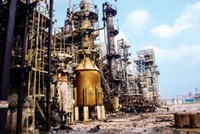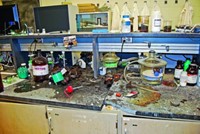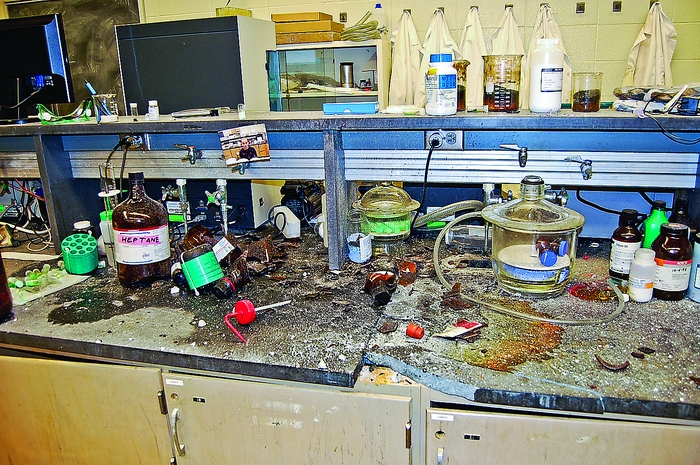Advertisement
Grab your lab coat. Let's get started
Welcome!
Welcome!
Create an account below to get 6 C&EN articles per month, receive newsletters and more - all free.
It seems this is your first time logging in online. Please enter the following information to continue.
As an ACS member you automatically get access to this site. All we need is few more details to create your reading experience.
Not you? Sign in with a different account.
Not you? Sign in with a different account.
ERROR 1
ERROR 1
ERROR 2
ERROR 2
ERROR 2
ERROR 2
ERROR 2
Password and Confirm password must match.
If you have an ACS member number, please enter it here so we can link this account to your membership. (optional)
ERROR 2
ACS values your privacy. By submitting your information, you are gaining access to C&EN and subscribing to our weekly newsletter. We use the information you provide to make your reading experience better, and we will never sell your data to third party members.
Lab Safety
University Lab Accident Under Investigation
Lab Safety: Texas Tech examination is first for chemical safety board
by Jeff Johnson
January 20, 2010
| A version of this story appeared in
Volume 88, Issue 4

A recent accident in a chemistry department laboratory at Texas Tech University will be investigated by the Chemical Safety & Hazard Investigation Board (CSB), Chairman John Bresland announced on Jan. 19. The investigation at the Lubbock, Texas, university will be CSB's first examination of an accident in an academic research lab.
One student, Preston Brown, 29, was seriously injured in the Jan. 7 accident and remains in critical condition, according to Eric Finley, a spokesperson with University Medical Center in Lubbock. Brown is being treated in the hospital's burn center, where he has been since the accident. Initially, press accounts said two students were injured; however, university officials say only one was hurt.
Brown received severe burns and lacerations to his face and hands when a mixture of nickel hydrazine perchlorate exploded during the afternoon accident in Texas Tech's chemistry building, according to a police report. University officials told CSB the accident involved the detonation of a high-energy metal compound. Texas Tech, the board reported, has an agreement with Northeastern University in Boston to study high-energy materials for the Department of Homeland Security.
The board, Bresland says, recently began taking notice of accidents in school research lab and "wondering how could this happen in an academic lab environment? We are seeing serious accidents in high school and university labs every year, including a tragic fatality a year ago at UCLA" (C&EN, Aug. 3, 2009, page 29).
"I believe it is time to begin examining these accidents," Bresland continues, "to see if they can be prevented through the kind of rigorous safety management systems that we and others have advocated in industrial settings."
Along with conducting the Texas Tech investigation, Bresland says CSB will collect information on other laboratory accidents to determine whether a more detailed study of academic lab safety is merited. This study could occur in the next fiscal year, he says. Investigations Supervisor Don Holmstrom, who manages the board's Denver office, will lead the investigation, along with CSB Investigator Mary Beth Mulcahy, a physical chemist and a former academic researcher.
In a statement, Texas Tech Vice President of Research Taylor Eighmy said, "We appreciate the opportunity to collaborate with the U.S. Chemical Safety Board on the investigation of this incident. We look forward to completing our own internal investigation" Of the university's lab conduct, Eighmy pointed out, "Texas Tech is committed to safe practices and procedures. We have an excellent program in place, yet we believe this incident affords us an opportunity to proactively look at our safety training."
The university would not comment on the accident's cause or lab damage, nor would it provide information on the student.
The safety practices and culture at many university labs need to improve, says Russell Phifer, past chair of the American Chemical Society's Division of Chemical Health & Safety and Committee on Chemical Safety as well as a safety consultant.
"My impression is that CSB is very picky about what it investigates. They don't have a large staff and aren't rolling in dough," Phifer says. "So this investigation is very interesting. Maybe publicizing this particular investigation will wake up other institutions to the need to start paying attention and not lose track of the fact that there are hazardous materials and equipment in labs.
"On the other hand, I don't want mothers and fathers hearing about this and discouraging their kids from going into chemistry. This is important work and it should be done safely."
CSB has no regulatory authority. In its decade-long history, it has conducted root-cause investigations at more than 60 chemical industrial and distribution sites and issued 59 reports.





Join the conversation
Contact the reporter
Submit a Letter to the Editor for publication
Engage with us on Twitter